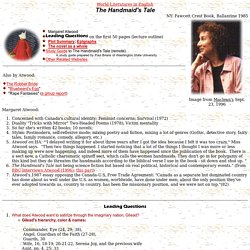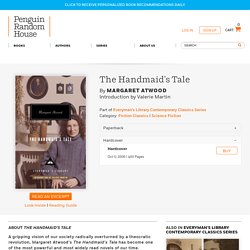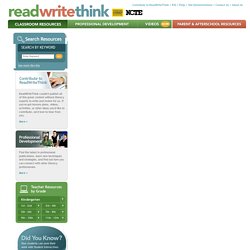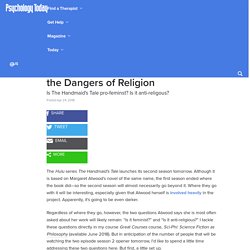

Handmaid. World Literatures in EnglishThe Handmaid's Tale NY: Fawcett Crest Book, Ballantine 1985 Margaret Atwood: Concerned with Canada's cultural identity; Feminist concerns; Survival (1972) Duality "Tricks with Mirror" Two-Headed Poems (1978); Victim mentality So far she's written 42 books; 10 novels; Styles: Postmodern, self-reflexive mode; mixing poetry and fiction, mixing a lot of genres (Gothic, detective story, fairy tales, family romance, comedy, allegory, etc.)

Atwood on HA: '''I delayed writing it for about three years after I got the idea because I felt it was too crazy,'' Miss Atwood says. ''Then two things happened. I started noticing that a lot of the things I thought I was more or less making up were now happening, and indeed more of them have happened since the publication of the book. What does Atwood want to satirize through the imaginary nation, Gilead? The Handmaid's Tale by Margaret Atwood - Reading Guide - PenguinRandomHouse.com.
An Interview with Margaret Atwood on her novel The Handmaid’s Tale Was there any special research involved in writing The Handmaid’s Tale?

I clipped articles out of newspapers. I now have a large clippings file of stories supporting the contentions in the book. In other words, there isn’t anything in the book not based on something that has already happened in history or in another country, or for which actual supporting documentation is not already available. It’s hard to pin down a genre for this novel. You seem to see a role for the novel beyond entertainment.I was once a graduate student in Victorian literature and I believe as the Victorian novelists did, that a novel isn’t simply a vehicle for private expression, but that it also exists for social examination. Language and Power in The Handmaids Tale and the World. Home › Classroom Resources › Lesson Plans Lesson Plan Student Objectives Session One Session Two Extensions Student Assessment/Reflections Students will: identify and analyze examples of neologisms, Biblical language, and Offred's unique language musings.articulate the significance of language patterns that they find in Atwood's writing.apply knowledge of literary themes to articulate the connections between specific textual examples and larger themes.apply their findings about language in Atwood's work to examples of official language in their own world. back to top Session One.

Turning-pages-the-revival-of-dystopian-literature-20180531-h10s1t. She looks back to that time in her introduction to the new illustrated Folio Society's edition of her novel, and finds very little reflection on her story in the journal she was keeping at the time she wrote it: "Perhaps that was because I thought I knew where it was going, and felt no need to interrogate myself. " Three things of interest to her came together in the novel, she says. One was her interest in dystopian literature – and indeed, The Handmaid's Tale now ranks with Nineteen Eighty-Four, Brave New World and Fahrenheit 451 as one of the great 20th-century depictions of a nightmare future.
The second thing was her study of 17th and 18th century America, and the third was her fascination with dictatorships. She made a rule for herself: she would not include anything that human beings had not done already in some place or time, or for which the technology didn't already exist. Margaret Atwood’s Grimly Relevant Additions to the “Handmaid’s Tale” Audiobook. “Are there any questions?” User Data and Cookie Consent. Margaret Atwood, author of ‘The Handmaid’s Tale,’ talks Trump, dystopian politics and fake news.
The Handmaid’s Tale, Feminism, and the Dangers of Religion. The Hulu series The Handmaid’s Tale launches its second season tomorrow.

Although it is based on Margaret Atwood’s novel of the same name, the first season ended where the book did—so the second season will almost necessarily go beyond it. Where they go with it will be interesting, especially given that Atwood herself is involved heavily in the project. Apparently, it’s going to be even darker. Regardless of where they go, however, the two questions Atwood says she is most often asked about her work will likely remain: “Is it feminist?” And “Is it anti-religious?” Teaser Poster from Season 1 Source: Hulu/Coming Soon. The real-life events that inspired The Handmaid’s Tale. The Handmaid’s Tale offers up a bleak world in which women’s ability to control their own reproduction, and particularly to access safe abortion, is non-existent.
This idea is introduced gradually over time: in the book, for example, Offred sees the bodies of hanged doctors who have carried out abortions and comments that “in the time before… such things were legal.” Culture - Why The Handmaid’s Tale is so relevant today. A white, wide-brimmed bonnet and a red cloak have come to mean one thing: women’s oppression.

Margaret Atwood’s 1985 novel The Handmaid’s Tale seared this image into our souls with its depiction of a near-future dystopia in which women are forced into reproductive slavery to bear the children of the elite – and wear this uniform to underline their subservience. For more than three decades, the image has shown up on the covers of the book around the world, on posters from the 1990 film, in ads for the 2017 TV series, and even on real women at demonstrations for reproductive rights. More like this: - The fiction that changed history - How Harry Potter became a rallying cry - Why tyrants love to write poetry.